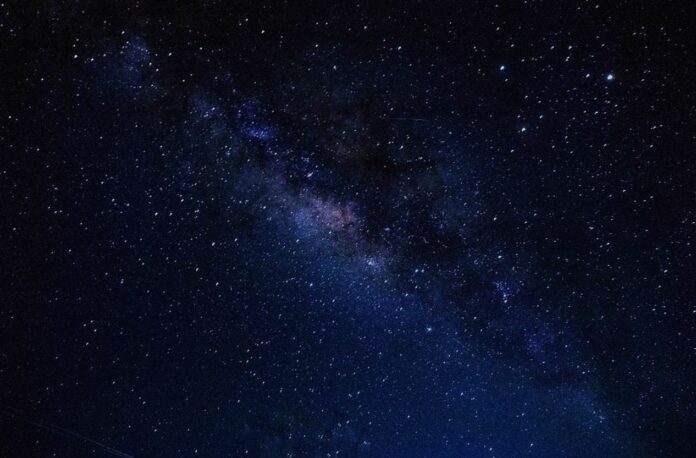An alarming study conducted by Globe at Night, a citizen science program administered by the National Science Foundation’s NOIRLab, has revealed that the number of visible stars is rapidly declining.
The research shows that the night sky has become less visible due to artificial lights at a faster rate than predicted by satellite data.
The study, which was published in the journal Science, shows how citizen scientists can make unique contributions to important fields of research.
On a clear, dark night, a person should be able to see several thousand stars, from the bright arc of the Milky Way to dozens of complicated constellations.
Unfortunately, increasing light pollution has prevented around 30% of people worldwide and 80% of people in the United States from seeing their home galaxy at night.
The problem is getting worse very quickly, says a new paper in the journal Science.
New study based on citizen science throws worrisome light on the issue of “skyglow” — the diffuse lighting of the night sky, which is a sort of light pollution.
The crowd-sourced observations for this research were gathered as part of Globe at Night, a project created by NRAO astronomer Connie Walker and maintained by NSF’s NOIRLab.
According to the study, skyglow is growing faster than satellite measurements of the Earth’s surface brightness at night have shown.
“At this rate of change,” comments lead author Christopher Kyba, “a child born in a location where 250 stars were visible would be able to see only abound100 by the time they turned 18.”
Light pollution is a well-known issue that has many negative effects, not just on astronomy. It also affects the health of people and animals because it messes up the natural cycle of the sun going down and the stars coming out. Biological systems have evolved along with this cycle.
In addition, the extinction of visible stars is a tragic loss of our cultural legacy. Until not too long ago, people all over the world had a great view of the night sky. This nightly show had an effect on ancient cultures, as shown by the myths it inspired and the buildings that were built to line up with celestial bodies.
Even though this is a well-known problem, the changes in the sky’s brightness over time are not well known, especially on a global scale.
Since 2006, Globe at Night has been keeping track of how many stars can be seen. The Globe at Night online app is accessible from any computer or mobile device, allowing anybody to contribute observations.
Participants are shown a number of star maps after they put in the correct date, time, and location. They then note which one corresponds most closely to what they saw in the sky without telescopes or other equipment.
This calculates the “naked eye limiting magnitude,” or the amount of brightness required for an item to be seen. Because fainter things become invisible as the sky becomes brighter, this may be used to gauge how brilliant skyglow is.
The paper’s authors looked at more than 50,000 observations sent to Globe at Night between 2011 and 2022. To make sure the results were consistent, they left out entries that were affected by things like clouds or the moon.
They zeroed down on European and North American data since there was a significant number of observations across both continents throughout the whole decade.
Based on satellite measurements, the research concludes that the sky is brightening at a faster pace in emerging nations as the use of artificial lighting becomes more commonplace.
After coming up with a new way to turn these observations into projections of the change in skyglow, the researchers noted that the loss of visible stars reported by Globe at Night shows that the sky has been getting brighter by 9.6% per year over the past ten years. This is substantially more than the approximately 2% worldwide rise in surface brightness that satellites monitor every year.
“This shows that existing satellites aren’t sufficient to study how Earth’s night is changing,” adds Kyba. “We’ve developed a way to ‘translate’ Globe at Night observations of star visibility made at different locations from year to year into continent-wide trends of sky brightness change. That shows that Globe at Night isn’t just an interesting outreach activity, it’s an essential measurement of one of Earth’s environmental variables.”
Existing satellites aren’t good at measuring skyglow as it looks to humans because there aren’t any instruments that can monitor the whole Earth and pick up wavelengths shorter than 500 nanometers, which is the color cyan.
But since shorter wavelengths scatter more readily in the atmosphere, they provide a disproportionately large contribution to skyglow.
LEDs with a white color temperature have an emission peak between 400 and 500 nanometers, making them ideal for use as high-efficiency outdoor lighting.
“Since human eyes are more sensitive to these shorter wavelengths at nighttime, LED lights have a strong effect on our perception of sky brightness,” points out Kyba. “This could be one of the reasons behind the discrepancy between satellite measurements and the sky conditions reported by Globe at Night participants.”
In addition to wavelength issues, space-based detectors do not measure light emitted horizontally very effectively, such as from lighted signs or windows, despite the fact that these sources are important contributors to skyglow as viewed from the ground. Therefore, crowdsourced observations will always be helpful for examining the direct impacts of sky brightness on people.
“The increase in skyglow over the past decade underscores the importance of redoubling our efforts and developing new strategies to protect dark skies,” adds Walker. “The Globe at Night dataset is indispensable in our ongoing evaluation of changes in skyglow, and we encourage everyone who can to get involved to help protect the starry night sky.”
Source: 10.1126/science.abq7781
Image Credit: Getty
